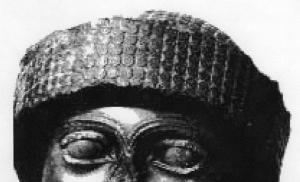The tragedy of the male chromosome.
- Tell me, professor! You said that in 5 million years the Sun will reach such a size that it will engulf the Earth. This is true?
- No. This will happen only in 5 billion years.
- A! Well, thank God!
Today, news is circulating in the press that soon “ the world will be left without men", What " male Y chromosome - and with it the whole masculine- are in danger of extinction", What " men will disappear like dinosaurs», « will disappear from the face of the Earth», « will disappear like biological species " Can these sensations be trusted? What is the Y chromosome and what is it for? What is really happening to her? Is there really a threat to the male population? This is what this article is about.
Human hereditary material is organized into 22 pairs of non-sex chromosomes (autosomes) and two sex chromosomes. We get half of our chromosomes from our father, half from our mother. Women have two X chromosomes, and men have one X and one Y chromosome. In fact, the picture is somewhat more complex. Approximately one in five hundred men has two X and one Y chromosome (XXY), and one in a thousand has one X and two Y (XYY). Every thousandth woman has three X (XXX).
Having more than two sex chromosomes is not fatal, but can lead to developmental disorders. In XYY men, the disturbances are insignificantly expressed: slight deterioration is observed mental development, increased growth, but at the same time fertility (the ability to leave offspring) is preserved. XXY men are usually infertile, they have less of the male sex hormone testosterone, and their genitals are less developed. XXX women are typically fertile, in some cases with developmental delays. A change in the copy number of autosomes is much more dangerous: three copies of the 21st chromosome are the cause of the development of Down syndrome, tripling of any of the remaining chromosomes is incompatible with life.
It turns out that the sex of people is determined by the presence or absence of the Y chromosome: if the Y chromosome is present, the result is a man, if it is not present, the result is a woman. This system of sex determination is not the only one possible in the animal world. For example, in the fruit fly Drosophila, sex is determined by the number of X chromosomes and does not depend on the presence of a Y chromosome. In birds, unlike humans, two identical sex chromosomes are observed in males, and in females the sex chromosomes are different. The platypus (unique oviparous mammal with a beak) there are as many as 10 sex chromosomes, which are linked in chains of five: there are XXXXXXXXXXX females and XYXYXYXYXY males. Moreover, one part of the platypus sex chromosome chain is similar to the sex chromosomes of birds, and the other is similar to the sex chromosomes of other mammals.
In very rare cases, among humans, rodents and some other species of mammals, you can find a male without a Y chromosome, as well as a female with a Y chromosome. It was shown that not the entire Y chromosome is needed to determine sex, but only a small part of it, just one gene. The SRY gene, located on the Y chromosome, is responsible for the development of the testes. If this gene “jumps” to another chromosome, the result may be an XX male. If a mutation knocks out the SRY gene on the Y chromosome, an XY female may be produced.
In 1991, the scientific journal Nature published the work of molecular biologist Peter Koopman, who managed to insert the SRY gene from the Y chromosome of mice into mouse embryos with two X chromosomes. These transgenic mice appeared to be male. This confirmed that the key genetic difference between men and women lies in a single gene.
But how can one gene have such a profound effect on human development? It turned out that the SRY gene can activate other genes responsible for the development of male sexual characteristics. In the female, these genes are turned off, but the appearance of the SRY gene can lead to their inclusion. In other words, every woman's genome contains almost all the necessary instructions for the development of a man, but these instructions are kept under lock and key. The SRY gene is the key to this lock.
Although Koopman's work showed that one gene is enough to produce XX mice with all external signs males, the resulting males were sterile. This means that for full development male one gene is still not enough. Nevertheless, many scientists are inclined to believe that the number of genes important for the development of full-fledged men on the Y chromosome is small.
Recent evidence suggests that the Y chromosome became the sex chromosome approximately 150 million years ago. At that time, the X and Y chromosomes were very similar, just like modern non-sex chromosomes. Since then, the Y chromosome has steadily decreased in size and lost about 97% of its genes. Having become a sex chromosome, it began to accumulate genes that were beneficial for men but harmful to women, and gradually got rid of everything else.
In addition, the Y chromosome mutates almost 5 times faster than other chromosomes. It is believed that this is due to the fact that the appearance of male reproductive cells is preceded by a large number of divisions. The fact is that with each cell division it is necessary to copy chromosomes so that each new cell receives a full set of genetic material. But the DNA copying system is not ideal: with each copying, errors, peculiar typos, and mutations occur. The Y chromosome goes through a large number of copies in each generation, because it is inherited only through male reproductive cells, which means it accumulates more errors related to copying. Autosomes are inherited from both men and women, which means that in half of generations they are inherited through female germ cells. As a result, on average they go through fewer divisions per generation and accumulate fewer mutations.
If you roughly calculate the rate at which genes disappear from the Y chromosome and the number of genes remaining on it, you can imagine that the Y chromosome will lose all its genes in about ten million years. Today there is a debate about whether the Y chromosome is at risk complete disappearance in future. Firstly, Koopman's experiments show that the Y chromosome is not so necessary: if a couple of genes important for sex determination jump from the Y chromosome to the autosome, we will get new system gender determination. In such a system, the Y chromosome can be gotten rid of without any special consequences. Indeed, in some species of rodents the Y chromosome was completely lost during evolution, indicating that the above scenario is indeed possible. Another point of view is that nothing will happen to the Y chromosome. Today it has been shown that there are a number of evolutionary mechanisms that actively preserve the genes remaining on the Y chromosome. It is not necessary that the Y chromosome will continue to lose the genes remaining on it at the same rate at which it lost them before. Despite the presence different points However, scientists agree that a decrease in Y will not lead to catastrophic consequences for humanity. The men will stay.
Image of the Y chromosome underneath electron microscope. Photo from visualphotos.com.
Mysteries of the Y chromosome
The Y chromosome is unlike the other 45 chromosomes in the human genome. She has no pair, she “collects” all possible mutations, and many researchers are confident that soon the male sex chromosome will disappear altogether. Moreover, as it turned out recently, it is not really needed for reproduction.
Scientists predict that the human Y chromosome could potentially completely lose its function and disappear from the genome within the next ten million years. The “male” sex chromosome differs significantly from other chromosomes, and, in particular, from the X chromosome in that during reproduction an individual is not able to exchange genetic sections. As a result, her hereditary material has become impoverished and the chromosome has accumulated mutations that are passed on from generation to generation. But don’t panic: as recent studies have shown, in the future people will be able to have children without the participation of the Y chromosome.
Male feature
Until recently, it was believed that the X and Y chromosomes appeared about 300 million years ago, but more recently scientists have discovered that chromosomal sex determination was absent as early as 166 million years ago.
According to the most common theory, the X and Y chromosomes arose from a pair of identical chromosomes when a gene arose in ancient mammals, one of the alleles of which directed the development of the body according to the male type. The chromosomes carrying this allele became Y chromosomes, and the second chromosome in this pair became the X chromosome. Thus, the X and Y chromosomes initially differed in only one gene. Over time, genes that are beneficial for males and harmful or irrelevant for females began to develop on the Y chromosome.
The Y chromosome does not recombine with the X chromosome during the maturation of germ cells (gametogenesis), so it can only change as a result of mutations. The resulting genetic information is not rejected or “diluted” by new gene variations, and therefore is passed on from father to son over many generations with virtually no changes. Over time, the number of harmful mutations inevitably increases.
During the process of gametogenesis, sperm undergo multiple cell divisions, and each of them provides the opportunity for the accumulation of mutations. In addition, sperm are located in the highly oxidative environment of the testicles, which contributes to the emergence of new mutations. This is why the Y chromosome “breaks” much more often than other chromosomes.
Stop the decay of the “male” chromosome
Over the course of evolution, the human Y chromosome has lost most of the genes it originally contained, and now, according to various estimates, contains from 45 to 90 genes, compared with about 1,400 genes on the X chromosome. Scientists previously predicted that, with an estimated rate of gene loss of 4.6 genes per million years, the human Y chromosome could potentially lose its function completely within the next 10 million years.
But there is another view: the authors of a study conducted at the Whitehead Institute for Biomedical Research that the rapid loss of genes - genetic "decay" that characterized the early evolution of the male sex chromosome has faded, and the Y chromosome will remain relatively stable for the next tens of millions of years. .
The researchers sequenced 11 million base pairs of the Y chromosome of rhesus macaques. By comparing this sequence with a similar region on the male sex chromosome, as well as on the Y chromosome of chimpanzees, scientists concluded that the genetic composition of the male sex chromosome has remained almost unchanged over the past 25 million years.
According to one of the study's authors, Jennifer Hughes, given that "in humans, only one gene has been lost on the Y chromosome compared to rhesus macaques, we can be confident that in the next millions of years male the chromosome will not disappear.”
Conception withoutY-chromosomes
Hawaiian researchers have found that male mice only need two genes from the Y chromosome to conceive healthy offspring. The authors of the article believe that in the future it is possible that a technique will appear that will allow human reproduction to be done without the Y chromosome at all. In addition, the obtained result potentially has great importance to combat male infertility.
Scientists used germ cells obtained from male mice in which only two genes were left from the Y chromosome - SRY (Sex-determining Region of Y) - the most significant gene on the Y chromosome, which is responsible for the development of the body according to the male type, production male hormones and spermatogenesis, and spermatogonia proliferation factor Eif2s3y. As researchers have established, Eif2s3y is the only gene on the Y chromosome required for normal sperm formation.
The resulting male germ cells were then in vitro eggs are fertilized using the intracytoplasmic injection (ROSI) method. The developed embryos were implanted into the uteruses of females. As a result of this procedure, 9 percent of pregnancies resulted in the birth of healthy offspring, and in males with a complete Y chromosome this figure was 26 percent. In the future, according to scientists, it will be possible to do without the Y chromosome altogether if it is defective. If genes that interact with genes on the Y chromosome are found on other chromosomes, then activation of such partner genes could theoretically completely replace their functions.
Cancer protection?
Recently in the magazine Nature published data finding that loss of the Y chromosome in blood cells (white blood cells), often seen in older men, is associated with an increased risk of developing oncological diseases and earlier mortality compared to women.
This phenomenon was first described approximately 50 years ago and until now its causes and consequences remained largely unclear. Now Swedish scientists have studied blood samples from 1,153 elderly men aged 70 to 84, who were followed in clinics from the age of 40. As it turned out, men who had Y chromosome loss in most of their blood samples lived an average of 5.5 years less compared to those who did not experience this phenomenon. In addition, an increase in the number of such blood cells significantly increased the risk of men dying from cancer.
“Many people believe that the Y chromosome contains only genes involved in sex determination and sperm production, but in fact its genes are also involved in other important functions, such as potentially playing a role in preventing the development of tumors,” the authors noted in your article. “Our hypothesis is that age-related loss of the Y chromosome impairs the immune vigilance of blood cells, allowing tumor cells to grow uncontrollably and transform into cancer.”
The findings suggest that testing blood for the presence of leukocytes that have lost the Y chromosome could be a new approach to identifying an increased risk of cancer in men. At the same time, the researchers emphasized that the presence of such cells in small quantities is not very dangerous, but their predominance may indicate a high risk of developing cancer.
The Y chromosome, the most important male sexual characteristic, is extremely susceptible to influence external factors. Due to the fact that the chromosome is unpaired, it does not participate in recombination and accumulates all mutations, both harmful and beneficial. Scientists have repeatedly predicted a quick end to this strange gene cluster, but it still holds on - as befits a real male chromosome.
Elena Sharifullina
The Y chromosome is unlike the other 45 chromosomes in the human genome. She has no pair, she “collects” all possible mutations, and many researchers are confident that soon the male sex chromosome will disappear altogether. Moreover, as it turned out recently, it is not really needed for reproduction.
Photo from visualphotos.com.
Scientists predict that the human Y chromosome could potentially completely lose its function and disappear from the genome within the next ten million years. The “male” sex chromosome differs significantly from other chromosomes, and, in particular, from the X chromosome in that during reproduction an individual is not able to exchange genetic sections. As a result, her hereditary material has become impoverished and the chromosome has accumulated mutations that are passed on from generation to generation. But don’t panic: as recent studies have shown, in the future people will be able to have children without the participation of the Y chromosome.
Male feature
Until recently, it was believed that the X and Y chromosomes appeared about 300 million years ago, but more recently scientists have discovered that chromosomal sex determination was absent as early as 166 million years ago.
According to the most common theory, the X and Y chromosomes arose from a pair of identical chromosomes when a gene arose in ancient mammals, one of the alleles of which directed the development of the body according to the male type. The chromosomes carrying this allele became Y chromosomes, and the second chromosome in this pair became the X chromosome. Thus, the X and Y chromosomes initially differed in only one gene. Over time, genes that are beneficial for males and harmful or irrelevant for females began to develop on the Y chromosome.
The Y chromosome does not recombine with the X chromosome during the maturation of germ cells (gametogenesis), so it can only change as a result of mutations. The resulting genetic information is not rejected or “diluted” by new gene variations, and therefore is passed on from father to son over many generations with virtually no changes. Over time, the number of harmful mutations inevitably increases.
During the process of gametogenesis, sperm undergo multiple cell divisions, and each of them provides the opportunity for the accumulation of mutations. In addition, sperm are located in the highly oxidative environment of the testicles, which contributes to the emergence of new mutations. This is why the Y chromosome “breaks” much more often than other chromosomes.
Stop the decay of the “male” chromosome
Over the course of evolution, the human Y chromosome has lost most of the genes it originally contained, and now, according to various estimates, contains from 45 to 90 genes, compared with about 1,400 genes on the X chromosome. Scientists previously predicted that, with an estimated rate of gene loss of 4.6 genes per million years, the human Y chromosome could potentially lose its function completely within the next 10 million years.
But there is another view: the authors of the study, conducted at the Whitehead Institute for Biomedical Research, believe that the rapid loss of genes - genetic "decay" that characterized the early evolution of the male sex chromosome has faded, and the Y chromosome will remain relatively stable for decades to come. million years.
The researchers sequenced 11 million base pairs of the Y chromosome of rhesus macaques. By comparing this sequence with a similar region on the male sex chromosome, as well as on the Y chromosome of chimpanzees, scientists concluded that the genetic composition of the male sex chromosome has remained almost unchanged over the past 25 million years.
According to one of the study's authors, Jennifer Hughes, given that "in humans, only one gene has been lost on the Y chromosome compared to rhesus macaques, we can be confident that in the next millions of years male the chromosome will not disappear.”
Conception without a Y chromosome
Hawaiian researchers have demonstrated that male mice only need two genes from the Y chromosome to conceive healthy offspring. The authors of the article believe that in the future it is possible that a technique will appear that will allow human reproduction to be done without the Y chromosome at all. In addition, the obtained result is potentially of great importance for the fight against male infertility.
Scientists used germ cells obtained from male mice in which only two genes were left from the Y chromosome - SRY (Sex-determining Region of Y) - the most significant gene on the Y chromosome, which is responsible for the development of the body according to the male type, the production male hormones and spermatogenesis, and spermatogonia proliferation factor Eif2s3y. As researchers have established, Eif2s3y is the only gene on the Y chromosome required for normal sperm formation.
The resulting male germ cells were then in vitro eggs are fertilized using the intracytoplasmic injection (ROSI) method. The developed embryos were implanted into the uteruses of females. As a result of this procedure, 9 percent of pregnancies resulted in the birth of healthy offspring, and in males with a complete Y chromosome this figure was 26 percent. In the future, according to scientists, it will be possible to do without the Y chromosome altogether if it is defective. If genes that interact with genes on the Y chromosome are found on other chromosomes, then activation of such partner genes could theoretically completely replace their functions.
Cancer protection?
Recently in the magazine Nature published data that found that loss of the Y chromosome in blood cells (white blood cells), often observed in older men, is associated with an increased risk of cancer and earlier mortality than women.
This phenomenon was first described approximately 50 years ago and until now its causes and consequences remained largely unclear. Now Swedish scientists have studied blood samples from 1,153 elderly men aged 70 to 84, who were followed in clinics from the age of 40. As it turned out, men who had Y chromosome loss in most of their blood samples lived an average of 5.5 years less compared to those who did not experience this phenomenon. In addition, an increase in the number of such blood cells significantly increased the risk of men dying from cancer.
“Many people believe that the Y chromosome contains only genes involved in sex determination and sperm production, but in fact its genes are also involved in other important functions, such as potentially playing a role in preventing the development of tumors,” the authors noted in your article. “Our hypothesis is that age-related loss of the Y chromosome impairs the immune vigilance of blood cells, allowing tumor cells to grow uncontrollably and transform into cancer.”
The findings suggest that testing blood for the presence of leukocytes that have lost the Y chromosome could be a new approach to identifying an increased risk of cancer in men. At the same time, the researchers emphasized that the presence of such cells in small quantities is not very dangerous, but their predominance may indicate a high risk of developing cancer.
The Y chromosome, the most important male sexual characteristic, is extremely susceptible to the influence of external factors. Due to the fact that the chromosome is unpaired, it does not participate in recombination and accumulates all mutations, both harmful and beneficial. Scientists have repeatedly predicted the end of this strange gene cluster, but it still holds on - as befits a real male chromosome.
How does the process of birth of men and women take place? The X and Y chromosomes are responsible for this. And it all begins when 400 million sperm rush to search for an egg. This is not such a difficult task as it might seem at first glance. In the human body, the egg can be compared to a huge star, towards which small sperm star fighters are rushing from all sides.
Now let's talk about chromosomes. They contain all the information necessary for the creation of man. A total of 46 chromosomes are needed. They can be compared to 46 thick volumes of an encyclopedia. Each person receives 23 chromosomes from their mother, and the remaining 23 from their father. But only 2 are responsible for sex, and one must be the X chromosome.
If you get a set of 2 X chromosomes, you will use the women's restroom for the rest of your life. But if the set consists of X and Y, then in this case you are doomed to go to school for the rest of your days. men's toilet. At the same time, you need to know that the man bears full responsibility for gender, since the Y chromosome is contained only in the sperm, and it is absent in the egg. So the birth of boys or girls is entirely dependent on male genetic material.
A remarkable fact is that to recreate the male sex, the Y chromosome is not needed at all. Only an initial push is needed for the development program to start male body. And it is provided by a special sex determination gene.
X and Y chromosomes are not equal. The first one takes on the main work. And the second only protects the genes associated with it. There are only 100 of them, while the X chromosome carries 1,500 genes.
From each X chromosome, one gene is needed to form the male sex. And for the formation of the female sex, two genes are needed. It's like a pie recipe with one cup of flour. If you take two glasses, then everything will change dramatically.
However, you should know that the female embryo, having two X chromosomes, ignores one of them. This behavior is called inactivation. This is done so that 2 copies of the X chromosomes do not produce twice as many genes as required. This phenomenon is referred to as gene dosage compensation. An inactivated X chromosome will be inactive in all subsequent cells resulting from division.
This shows that the cells of a female embryo form a rather complex mosaic, assembled from inactive and active paternal and maternal X chromosomes. As for the male embryo, no inactivation of the X chromosome occurs in it. This means that women are genetically more complex than men. This is a rather loud and bold statement, but a fact is a fact.
But as for the genes of the X chromosome, of which there are 1,500, many of them are associated with brain activity and determine human thinking. We all know that the chromosome sequence of the human genome was determined in 2005. It was also found that high percent X chromosome genes ensure the generation of a protein that is involved in the formation of the medulla.
Some of the genes are involved in the formation of the brain mental activity. These are verbal skills social behavior, intellectual abilities. Therefore, today scientists consider the X chromosome to be one of the main points of knowledge.
Y-chromosome
In the body of every man there is a so-called Y-chromosome that makes a man a man. Typically, chromosomes in the nucleus of any cell are arranged in pairs. For Y- paired chromosome is X-chromosome. At conception, the future new organism inherits all of its genetic information from its parents (half the chromosomes from one parent, half from the other). From his mother he can only inherit X- chromosome, from the father - either X, or Y. If an egg contains two X- chromosomes, a girl will be born, and if X- And Y- chromosomes - boy.
For almost 100 years, geneticists believed that the tiny chromosome (a Y-the chromosome is really the smallest, noticeably smaller X-chromosome) is simply a “stub”. The first guesses that the chromosome set of men differs from that of women were put forward in the 1920s. Y-chromosome was the first chromosome discovered using a microscope. But to determine the presence of any genes localized in Y- chromosome turned out to be impossible.
In the middle of the 20th century. geneticists have suggested that several very specific genes may be contained in Y- chromosome. However, in 1957, at a meeting of the American Society of Human Genetics, these hypotheses were criticized. Y- the chromosome was officially recognized as a “dummy”, not carrying any important hereditary information. The point of view has been established that “ Y“The chromosome, of course, carries some kind of gene that determines the sex of a person, but no other functions are assigned to it.”
Just 15 years ago Y- the chromosome did not arouse much interest among scientists. Now decryption Y- chromosomes is part of the project to decipher the human genome, which is being carried out international group geneticists. Y During the study it became clear that
-the chromosome is far from being as simple as it seemed at first. Y- Information about the genetic map of this chromosome is extremely important because It is here that the answers to questions about the causes of male infertility lie.
Research Y chromosomes may provide answers to many other questions: Where did man appear? How did the language develop? What makes us different from monkeys? Is the “war of the sexes” really programmed into our genes? Now geneticists have begun to understand that-chromosome is something unique in the world of chromosomes. It is extremely highly specialized: all the genes contained in it (and there were about two dozen of them) are responsible either for the production of sperm by the male body, or for “related” processes. And, naturally, the most important gene on this chromosome is
SRY Y-– in the presence of which the human embryo develops along the male path. X- Approximately 300 million years ago, it did not exist in nature chromosomes. Most animals had a pair chromosomes, and sex was determined by other factors such as temperature (in some reptiles such as crocodiles and turtles, the same egg can still hatch into either a male or female, depending on temperature). Then a mutation occurred in the body of a certain mammal, and the new gene that appeared began to determine “
male type development" for carriers of this gene., but for this he needed to block the process of replacement with an allelic gene from X-chromosomes. These long-standing events determined the uniqueness Y- chromosomes: it is found only in male organisms. Y- Investigating mutations in chromosome, scientists can estimate how distant men from two ethnic groups are from our own common ancestor
. Some of the results obtained in this way were quite surprising. Last November, a branch of biology called archaeogenetics took a big step forward. Leading scientific journal, Nature Genetics , offered new version family tree Y- humanity, based on hitherto unknown variations, so-called haplotypes chromosomes. These data confirmed that the ancestors modern people
 migrated from Africa. Y- It turned out that “genetic Eve,” the progenitor of all humanity, is 84 thousand years older than “genetic Adam,” if age is measured by Y- chromosome.
migrated from Africa. Y- It turned out that “genetic Eve,” the progenitor of all humanity, is 84 thousand years older than “genetic Adam,” if age is measured by Y- chromosome.
Female equivalent
chromosomes, i.e. The genetic information passed only from mother to daughter is known as m-DNA. This is the DNA of mitochondria, which is the source of energy in the cell. For the past few years, it has been generally accepted that "mitochondrial Eve" lived about 143 thousand years ago, which does not fit with the estimated age of "Adam" of 59 thousand years. In fact, there is no contradiction here. These data only suggest that the different chromosomes found in Y- human genome
, appeared in
-the chromosome is far from being as simple as it seemed at first. Y different time . About 143 thousand years ago, a new variety of m-DNA appeared in the gene pool of our ancestors. It, like any successful mutation, spread more and more widely until it crowded out all other varieties from the gene pool. This is why all women now carry this new, improved version of m-DNA. The same happened with Y chromosome in men, but it took evolution another 84 thousand years to create a version that could displace all competitors.
Data obtained during the study Y-chromosomes confirm that the “war of the sexes” is programmed in genes. The fact that men and women have different life programs is now common knowledge. While a man can theoretically have an almost unlimited number of natural children, women are limited in this.
Special position Y- chromosome allows the genes located on it to influence only the male individual and “not worry” about how they affect female individuals.
It was found that the genes responsible for the production of sperm proteins mutate very quickly, apparently due to intense competition. Y The -chromosome contains a large number of these genes, and researchers are now trying to understand which ones are involved in this competition.
Availability Y- chromosome is a risk factor for the fetus due to the maternal immune response. This may explain some interesting patterns. For example, according to statistics, the more older brothers a man has (namely, brothers, not sisters), the more likely he is to develop homosexual tendencies. One possible explanation for this fact is that in Y- There is a gene on the chromosome responsible for the production of a masculinizing hormone called AMH. This hormone stops the development of glands, which, in its absence, turn into the uterus and ovaries. In addition, AMN causes an immune reaction on the part of the mother’s body, and the antibodies produced in this case prevent the hormone from performing another important function
, namely, to direct the development of the fetal brain according to the male type. Y- Isolation is one of the most important features Y chromosomes. Copying genes is accompanied by errors. When eggs and sperm are formed, parts of the paired chromosomes are swapped, and the damaged areas are discarded. But
The common picture of DNA copying as something like photocopying fails to convey the true dynamism of the genome. Although nature has tried to ensure the maximum accuracy of this procedure, just one piece of DNA, like an asteroid invading someone else's chromosome, can instantly change the sequence carefully preserved for many thousands of generations. These uninvited guests are called jumping genes, or transposons.
The vast majority of genes never leave their original chromosome. In contrast, jumping genes are “genome wanderers.” Sometimes they “jump” from one chromosome and “land” in a random place on another. They can insert themselves into the middle of a gene, causing chaos, or they can “moor” at the edge, slightly modifying its function. Aliens are usually “expelled” from ordinary chromosomes due to endless mixing of genes, but once on Y-chromosome they remain in it for millions of years. Sometimes, quite by accident, it allows them to do something wonderful. "Jumping emigrants" could turn Y-chromosome into the start button that starts evolution. The first of these Y- there were immigrants DAZ, discovered by D. Page (USA).
At the time when D. Page began to study Y-chromosome, all that was known about it was that it contained a gene Now geneticists have begun to understand that, which at the right moment triggers the development of male organs in the embryo. It is now known that Y-chromosome contains more than twenty genes (compare with 2 thousand genes in X-chromosome). Most of these genes are involved in sperm production or help the cell synthesize proteins. Gene DAZ probably arrived in Y- chromosome about 20 or 40 million years ago, approximately when the first primates appeared (perhaps the reason for their appearance was DAZ). The absence of this gene in a man’s body leads to a decrease or complete absence of spermatogenesis. According to statistics, one in six couples have problems conceiving a child, and for 20% of them the key factor is male sperm.
Currently, ectopic fertilization technology partially solves this problem. But bypassing the laws of nature is not in vain. Infertility, as paradoxical as it may sound, becomes hereditary.
Recently, British researchers made a bold assumption: the critical factor in the emergence of speech in humans was precisely a certain “jumping gene” that invaded Y-chromosome.
Gene DAZ by enhancing spermatogenesis allowed primates to flourish, but what gene was the impetus for the separation of humans from the primate lineage? A direct way to find it is with the human and chimpanzee genomes. A more elegant way is to imagine what the consequences of such mutations would be and where these mutations might be found.
This is exactly what was done at Oxford. At first, researchers assumed that there was a certain gene that had such an influence on brain development what has become possible speech
. Moreover, it was suggested that this gene takes a different form in men and women. Y At a conference in London in 1999, another research group announced that -gene discovered on chromosome PCDH X, whose activity most likely affects the functioning of the human brain, but not primates. This makes it a good candidate for a speech gene. Primates have it -version ( PCDHX Y-), but at some point in evolution it jumped to
chromosome. Y Scientists have been able to trace the connection -versions of this gene ( PCDHY -versions of this gene () with two turning points in human evolution. The first of these occurred about 3 million years ago, when the size of the human brain increased and the first tools appeared. But that is not all. A piece of DNA carrying
 , transformed again, splitting into two parts, so that the resulting segments turned over in their places. According to scientists, this happened 120–200 thousand years ago, i.e. just at the time when great changes took place in the manufacture of tools. Human African ancestors developed the ability to transmit information using symbols. Circumstantial evidence is all well and good, but how does this gene actually function? On this moment there are more questions than answers here, but the available data do not contradict the theory about the connection of this gene with the appearance of speech. It is likely one of a family of genes known as cadhedrins -version (/Y. They synthesize proteins that make up the membrane of nerve cells and are thus involved in the transmission of information. Genes
, transformed again, splitting into two parts, so that the resulting segments turned over in their places. According to scientists, this happened 120–200 thousand years ago, i.e. just at the time when great changes took place in the manufacture of tools. Human African ancestors developed the ability to transmit information using symbols. Circumstantial evidence is all well and good, but how does this gene actually function? On this moment there are more questions than answers here, but the available data do not contradict the theory about the connection of this gene with the appearance of speech. It is likely one of a family of genes known as cadhedrins -version (/Y. They synthesize proteins that make up the membrane of nerve cells and are thus involved in the transmission of information. Genes
active in some areas of the human fetal brain. Y- the chromosome can be thought of as a model of a capitalist economy. The winners, the genes that give an advantage, take everything because they don't mix with genes from other chromosomes.
Outsiders, because they usually affect fertility, going bankrupt almost instantly. That is, the genes that survive here must do something truly valuable for the organism. Y More likely, Y--chromosome has lost most of its genes during evolution, but all the remaining genes thrive. They must perform some elusive function, incomprehensible to us. Probably, to clarify this function, it is necessary to study the connection of genetic markers that allow us to trace a person’s ancestry with his abilities. The idea is dangerous in terms of ethical correctness, but it will provide an opportunity













